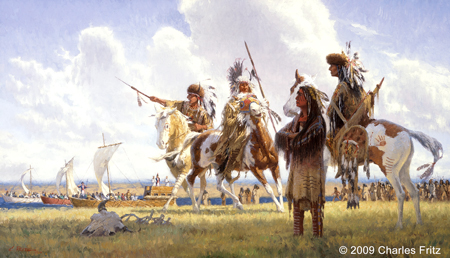The Seven Bands
Unfinished Diplomacy
30″ x 52″ oil on canvas
© 2009 by Charles Fritz. Used by permission.
Presently known as the Lakota people—often spelled Lahkota or more phonetically, lakhóta—Lewis and Clark most often called them Tetons. Teton is an English borrowing from Thíthuwa which despite numerous interpretations from historians and writers, has no definite meaning. Teton peoples are often referred to by the name of their band. There were three main groups, the Oglala, Brule, and Saone, and the latter group was divided into the Minneconjou, Hunkpapa, Sans Arc, Two Kettles, and Blackfoot—not to be confused with the Algonquian-speaking Blackfoot. Collectively, they are often called the seven bands of the Lakota Nation. At the time of the expedition, the bands typically lived separately, hunted freely within each other’s territory, and came together for community events. There was no evidence, however, of a centralized Lakota government.[1]Raymond J. DeMallie, Handbook of North American Indians: Plains Vol. 13 (Washington, D.C.: Smithsonian Institution, 2001), 794.
An informative name for the Teton is the Plains Sign Language gesture for the Sioux in general, a motion denoting cut throats and head decapitations.[2]Douglas R. Parks, Handbook of North American Indians: Plains Vol. 13, 749–751, 755. Also clear is the captains’ belief that the Teton Sioux threatened American trade in the upper Missouri:
These are the vilest miscreants of the savage race, and must ever remain the pirates of the Missouri, until such measures are pursued, by our government, as will make them feel a dependence on its will for their supply of merchandise. Unless these people are reduced to order, by coercive measures, I am ready to pronounce that the citizens of the United States can never enjoy but partially the advantages which the Missouri presents.[3]Moulton, Journals, 3:418
The Tetons were relatively new to the Missouri, and also relatively new to world of trade. Siouan-speaking peoples—possibly part of the Mound Builder culture during their prehistory—were recorded by early French explorers and missionaries as generally moving westward from Lake Michigan to lands between the Mississippi and Missouri rivers. Only after the smallpox epidemics of the late 18th century decimated the Arikaras, Mandans, and Hidatsas, did the Teton Sioux move into lands west of the Missouri. Immediately following the expedition, the Arikaras—not the Teton Sioux—became the gatekeepers of the American trade in the upper Missouri. The Tetons’ battles with America would come in the second half of the 19th century.
Encounters
That the expedition experienced Lakota Sioux Difficulties in late September 1804 is one of the more commonly related experiences of the Lewis and Clark Expedition. Two Sioux attacks, perhaps the Teton, occurred during the winter at Fort Mandan. Wanting to protect their hosts, the Mandans and Hidatsas, the captains ordered a military response. That show of force did not result in actual skirmishes. A third encounter was an attack on a hunting party. Joseph Whitehouse, on 14 February 1805, records that the hunters’ horses and weapons were taken by marauding Sioux. After a gift of cornbread, one of the horses was given back, and the party was able to safely return to the Knife River Villages.
On the 1806 return home, the captains went out of their way to avoid the Teton Sioux. After leaving the Arikara, the captains took evasive actions at the first sign of any nearby Indians. After a couple of false alarms, they finally met some Teton Sioux on 30 August 1806 who beckoned the captains to meet with them. The captains refused, essentially told the men off, and received a rude gesture in return. If anyone else offered insults or gestures during the encounter, they were omitted from the written record.
Treaties and Wars
The Treaty of 1851, for the first time, established boundaries for the Teton Sioux and other participating bands. Annuities for over half a century were promised in return for the right to build roads and military posts on Sioux lands. Thereafter, conflicts due to cultural and political misunderstandings between Oregon Trail emigrants, overzealous U.S. Army commanders, and treaty signers led to raids, massacres, and wars.[4]DeMallie, 795.
To protect Powder River lands, Oglala Red Cloud led a series of successful battles against the U.S. Army. Red Cloud’s War precipitated the 1868 Treaty of Fort Laramie that established the Great Sioux Reservation—including the Black Hills—for the Oglala, Miniconjou, Brulé, Yanktonai, and Arapaho signers. Hunkpapa Sitting Bull refused to sign and would become a symbol of native resistance and independence.[5]“Red Cloud’s War,” Wikipedia, https://en.wikipedia.org/wiki/Red_Cloud%27s_War accessed on 30 January 2021.
In 1874, Lieutenant Colonel George Armstrong Custer led the Black Hills Expedition to locate a site for a military post. The fact that Custer also found gold leaked to the public, and the Army was unable to stop prospectors from trespassing on Sioux lands. In May 1875, Sioux delegations including Brulé Spotted Tail, Red Cloud, and Minneconjou Lone Horn tried to persuade U.S. President Grant to honor the former treaties and keep the miners out. That fall, one meeting between government and Sioux representatives was held and the diplomatic solution was essentially abandoned.[6]DeMallie, 797.
Of the Lakota people’s struggles and conflicts between 1850 and 1890, much has been written. Many Lakota leaders became icons of independence, resistance, military leadership, bravery, and spirituality. Sitting Bull, whose Sun Dance vision prophesized of the defeat of Custer, was killed by Army soldiers with questionable motives as he was being arrested at Standing Rock at the end of 1890. Just two weeks later, on 29 December, nearly three hundred Lakota people would be killed at the Battle of Wounded Knee, also known as the Wounded Knee Massacre. After fighting with Crazy Horse at the Battle of the Little Bighorn and surviving the Wounded Knee Massacre, Oglala medicine man Black Elk worked with ethnologists to document his life and Oglala spiritual practices, notably in two books, The Sacred Pipe and Black Elk Speaks. His books have inspired both native and non-native peoples for generations.[7]DeMallie, 797; “Black Elk,” Wikipedia, https://en.wikipedia.org/wiki/Black_Elk and “Sitting Bull,” https://en.wikipedia.org/wiki/Sitting_Bull both accessed 30 January 2021.
Today, one half of enrolled Teton Sioux reside among several reservations each with a separate government.[8]“Lakota People,” Wikipedia, https://en.wikipedia.org/wiki/Lakota_people, accessed 21 January 2021. These include:
- Rosebud Indian Reservation: “home of the federally recognized Sicangu Oyate (the Upper Brulé Sioux Nation) also known as Sicangu Lakota, and the Rosebud Sioux Tribe”[9]“Rosebud Indian Reservation,” Wikipedia, https://en.wikipedia.org/wiki/Rosebud_Indian_Reservation, accessed 30 January 2021.
- Lower Brulé Indian Reservation[10]“Lower Brulé Indian Reservation,” Wikipedia, https://en.wikipedia.org/wiki/Lower_Brule_Indian_Reservation, accessed 30 January 2021.
- Pine Ridge Indian Reservation: home of the federally recognized Oglala Sioux Tribe[11]“Oglala,” Wikipedia, https://en.wikipedia.org/wiki/Oglala, accessed 30 January 2021.
- Standing Rock: Home to several Sioux subgroups including the Hunkpapa[12]“Standing Rock Indian Reservation,” Wikipedia, https://en.wikipedia.org/wiki/Standing_Rock_Indian_Reservation, accessed 30 January 2021.
- Cheyenne River Indian Reservation: “home of the federally recognized Cheyenne River Sioux Tribe or Cheyenne River Lakota Nation (Oyate).” It also includes Miniconjou, Sans Arc, Blackfoot, and Two Kettles.[13]“Cheyenne River Indian Reservation,” Wikipedia, https://en.wikipedia.org/wiki/Cheyenne_River_Indian_Reservation, accessed 30 January 2021.
- Fort Berthold
- Various others in the United States and Canada
For Further Reading
- Pekka Hämäläinen, Lakota America: A New History of Indigenous Power (New Haven: Yale University Press, 2019)
- Stephen E. Ambrose, Crazy Horse and Custer (New York: Anchor Books, 1996)
- Dee Brown, Bury My Heart at Wounded Knee (New York: Henry Holt and Company, 1971)
- John S. Gray, Centennial Campaign: The Sioux War of 1876 (Norman: University of Oklahoma Press, 1988).
- Donald Jackson, Custer’s Gold: The United States Cavalry Expedition of 1874 (New Haven, 1966).
- John G. Neihardt, Black Elk Speaks (Norman: Bison Books, 1961).
Selected Pages and Encounters
Flag Presentations
by Joseph A. Mussulman
Lewis and Clark usually distributed flags at councils with the chiefs and headmen of the tribes they encountered—one flag for each tribe or independent band.
Spirit Mound
An elevation of devilish spirits
by Joseph A. Mussulman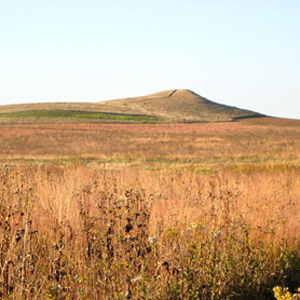
The visit to this prairie hill was among the more bizarre sidelights of the whole expedition, but evidently it was not entirely unexpected. Seventy-six years earlier, explorer Pierre La Véndrye called the place the “Dwelling of the Spirits.”
September 22, 1804
Fort aux Cedres
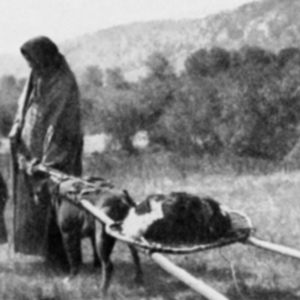
The expedition passes the abandoned Fort aux Cedres, a fur trading post built by Régis Loisel in present South Dakota. The hunters complain that the soils of the plains wear out their moccasins.
September 23, 1804
Signaling the Teton Sioux
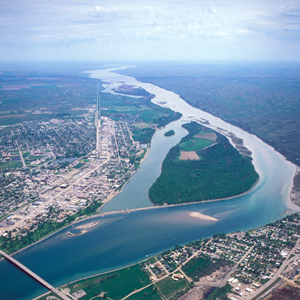
Below present Pierre, South Dakota, three Lakota Sioux boys say they have set signal fires to tell their villages the expedition is coming. The captains ask them to invite their chiefs to council.
September 24, 1804
Buffalo Medicine
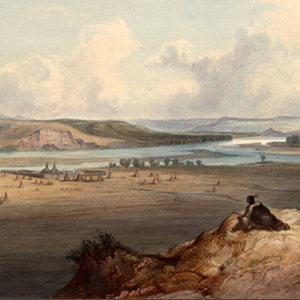
At present Pierre, South Dakota, the captains smoke with Buffalo Medicine, and a promise is made to return Pvt. Colter’s stolen horse and to meet with the captains tomorrow.
Pierre by Air
Standoff
by Joseph A. Mussulman
Lewis and Clark first met the Teton Sioux on 25 September 1804. One of Jefferson’s primary political objectives for the expedition was to create a peace treaty and trade agreement them, the most potent military and economic force on the lower Missouri.
Lakota Sioux Difficulties
Tough times at the Bad
by James P. Ronda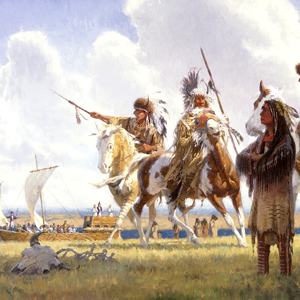
Ignorant of plains politics, Lewis and Clark barely averted disaster in their encounter with Black Buffalo’s people—an article by James P. Ronda from a keynote address to the Lewis and Clark Trail Heritage Foundation, Pierre, South Dakota, August 2002.
September 25, 1804
Good humor left behind
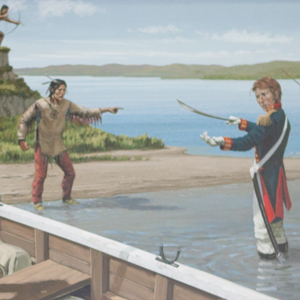
At Good Humor Island at present Pierre, South Dakota, a council with the Lakota Sioux brings diplomatic speeches, a military parade, and gifts. When the captains try to disembark, weapons are raised.
Bad ‘humered’ Island
Change of heart
by Joseph A. Mussulman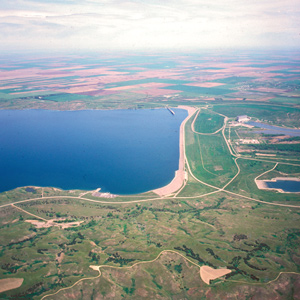
On the evening of 25 September 1804 after a negative encounter with the Lakota Sioux, the Corps camped on a nearby island Clark called “bad humered Island.” The next morning, the Indians had a change of heart.
September 26, 1804
Teton Sioux ceremony
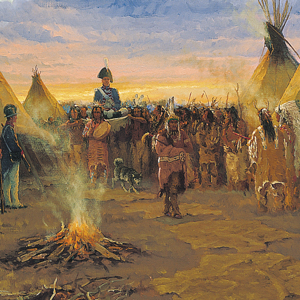
Clark and Lewis are ceremoniously carried into a Lakota Sioux village where they are feted with food and music. Clark sees several recently captured Omaha prisoners and asks for their return.
September 27, 1804
A lost anchor

Among the Lakotas near present Pierre, South Dakota, an anchor line is accidentally severed, and the men must act quickly to save the barge. Both the Sioux and expedition think an attack is imminent.
September 28, 1804
Leaving the Teton Sioux

When the expedition tries to leave, Lakota Sioux warriors grab the barge’s line, and weapons are readied. Tobacco is given, and they make about six miles camping on an island above present Oahe Dam.
September 29, 1804
Avoiding the Lakotas
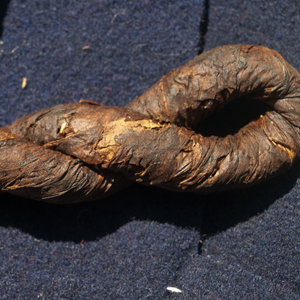
The expedition passes many Lakota Sioux who ask for tobacco. The captains decide not to land the barge, and at night near present Spring Creek, South Dakota, all but the guard sleep on the boats.
September 30, 1804
Sailing away

The expedition meets a band of Lakota Sioux. The captains give them some tobacco without landing. After a close call with the barge, a Sioux chief riding as a passenger decides to disembark.
October 22, 1804
Double Ditch village
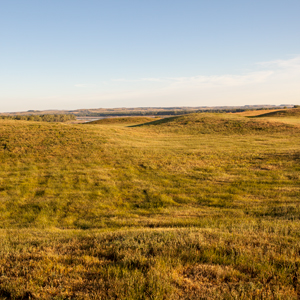
Moving up the Missouri, the expedition meets a group of Lakota Sioux on a raid, and the hunters do well. They end the day three miles above the abandoned Mandan village of Double Ditch.
November 30, 1804
A military reprisal

Responding to news of a deadly Sioux and Arikara attack on Mandan hunters about 25 miles from Fort Mandan, Clark leads a military force to Mitutanka to gather warriors and pursue the attackers.
February 16, 1805
Scorched earth
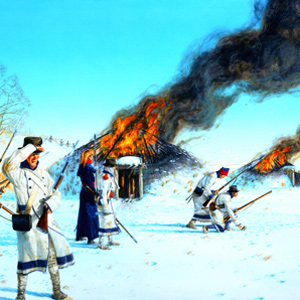
Many miles south of Fort Mandan and the Knife River Villages, Lewis and his soldiers continue their pursuit of a Sioux war party. They come to an old Mandan village where two lodges have been set afire.
February 28, 1805
Arikara and Sioux news

Traders arrive at the Knife River Villages with news and two plant specimens for Lewis. About six miles from Fort Mandan, several enlisted men cut down cottonwood trees to make dugout canoes.
August 15, 1806
Broken promises of peace
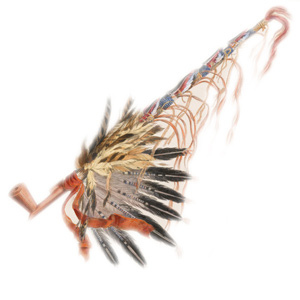
At the Knife River Villages in present North Dakota, the captains hear of several broken promises of peace among the tribes with whom they had established peace agreements on the outward journey.
August 24, 1806
Lookout Bend
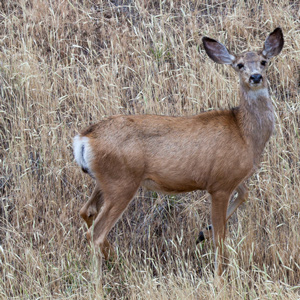
Despite high waves, the expedition makes 43 miles reaching Jean Vallé’s old trading post on Lookout Bend. Clark explores a bluff containing bentonite clay and blames the area’s lack of game on the Sioux.
August 25, 1806
Empty Lakota encampment
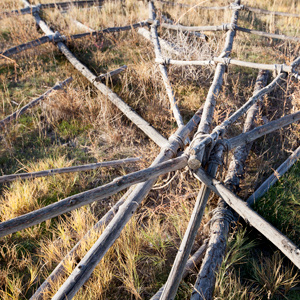
On their return down the Missouri, they pass an empty Lakota encampment and recall the “Troubleson Tetons” experienced on their way up the river in 1804. They camp above present Pierre, South Dakota.
August 26, 1806
Passing the Bad River
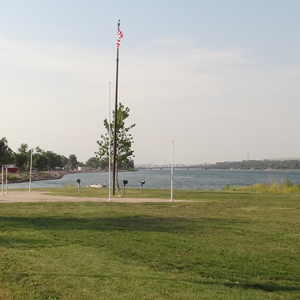
While passing the Bad River in present Pierre, South Dakota, Clark recalls how the Lakota Sioux attempted to stop them in 1804. They make about sixty miles and now expect to find those Indians.
August 30, 1806
Armed Lakotas
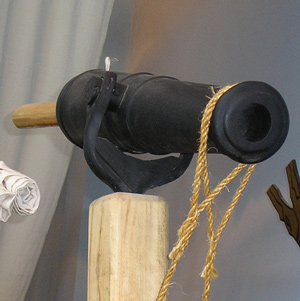
Clark recognizes several armed Lakotas from their 1804 encounter and tells them to stay away or be killed. They move on and camp in a defensive position near present Academy, South Dakota.
September 3, 1806
News from home

Moving down the Missouri, they meet a group of traders who tell them that Jefferson is again president and that Alexander Hamilton died in a duel with Aaron Burr. They camp above present Sioux City, Iowa.
September 6, 1806
A taste of whiskey

Moving down the Missouri along the present Nebraska-Iowa border, the expedition meets a large boat owned by Auguste Chouteau of St. Louis. Some men trade beaver skins for linen shirts and woven hats.
September 12, 1806
Given up for dead

At present St. Joseph, Missouri, the captains modify orders given to Pierre Dorion and Joseph Gravelines. An old military companion, Robert McClellan, says that they have all been given up for dead.
Notes
| ↑1 | Raymond J. DeMallie, Handbook of North American Indians: Plains Vol. 13 (Washington, D.C.: Smithsonian Institution, 2001), 794. |
|---|---|
| ↑2 | Douglas R. Parks, Handbook of North American Indians: Plains Vol. 13, 749–751, 755. |
| ↑3 | Moulton, Journals, 3:418 |
| ↑4 | DeMallie, 795. |
| ↑5 | “Red Cloud’s War,” Wikipedia, https://en.wikipedia.org/wiki/Red_Cloud%27s_War accessed on 30 January 2021. |
| ↑6 | DeMallie, 797. |
| ↑7 | DeMallie, 797; “Black Elk,” Wikipedia, https://en.wikipedia.org/wiki/Black_Elk and “Sitting Bull,” https://en.wikipedia.org/wiki/Sitting_Bull both accessed 30 January 2021. |
| ↑8 | “Lakota People,” Wikipedia, https://en.wikipedia.org/wiki/Lakota_people, accessed 21 January 2021. |
| ↑9 | “Rosebud Indian Reservation,” Wikipedia, https://en.wikipedia.org/wiki/Rosebud_Indian_Reservation, accessed 30 January 2021. |
| ↑10 | “Lower Brulé Indian Reservation,” Wikipedia, https://en.wikipedia.org/wiki/Lower_Brule_Indian_Reservation, accessed 30 January 2021. |
| ↑11 | “Oglala,” Wikipedia, https://en.wikipedia.org/wiki/Oglala, accessed 30 January 2021. |
| ↑12 | “Standing Rock Indian Reservation,” Wikipedia, https://en.wikipedia.org/wiki/Standing_Rock_Indian_Reservation, accessed 30 January 2021. |
| ↑13 | “Cheyenne River Indian Reservation,” Wikipedia, https://en.wikipedia.org/wiki/Cheyenne_River_Indian_Reservation, accessed 30 January 2021. |
Experience the Lewis and Clark Trail
The Lewis and Clark Trail Experience—our sister site at lewisandclark.travel—connects the world to people and places on the Lewis and Clark Trail.
Discover More
- The Lewis and Clark Expedition: Day by Day by Gary E. Moulton (University of Nebraska Press, 2018). The story in prose, 14 May 1804–23 September 1806.
- The Lewis and Clark Journals: An American Epic of Discovery (abridged) by Gary E. Moulton (University of Nebraska Press, 2003). Selected journal excerpts, 14 May 1804–23 September 1806.
- The Lewis and Clark Journals. by Gary E. Moulton (University of Nebraska Press, 1983–2001). The complete story in 13 volumes.
